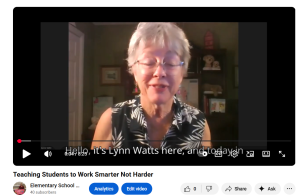Work Smarter, Not Harder: Teaching Students How to Learn Effectively
As elementary school counselors, part of our role is helping students build not just social-emotional skills but also strong learning habits. When students learn how to learn, they become more confident, engaged, and resilient in the classroom. Below are six key strategies counselors can teach—and practical ways to integrate them into small groups, classroom lessons, or individual sessions.
Previewing Material
Strategy: Teach students to scan material before diving in. Encourage them to look at titles, headings, pictures, and bolded words before reading.
Practical Tip: Use a picture book or short passage. Ask students to “take a walk through the book” before reading it together.
Benefit: Students develop a roadmap for learning, which improves comprehension and reduces overwhelm.
Looking for and Understanding Patterns
Strategy: Show students how to notice patterns in math, reading, and behavior. Patterns might be word families, number sequences, or repeated themes in a story.
Practical Tip: Play a quick “pattern detective” game where students highlight or circle repeated ideas or number sequences.
Benefit: Recognizing patterns helps students predict what comes next and strengthens critical thinking.
Setting Goals
Strategy: Guide students in setting short-term and long-term learning goals.
Practical Tip: Use a simple goal-setting sheet with prompts: “One thing I want to get better at is…” and “One step I will take today is…”
Benefit: Students build motivation, self-responsibility, and the ability to measure progress.
Connecting New Learning with Old
Strategy: Teach students to link new concepts to what they already know. For example, connecting a new math strategy to a familiar one, or linking a new vocabulary word to a known concept.
Practical Tip: Use a “bridge chart” where students draw a line from what they already know to the new concept.
Benefit: Connections improve retention and help learning feel meaningful rather than isolated.
Developing the Skill of Summarizing
Strategy: Show students how to “shrink” a lesson or story into just the main points.
Practical Tip: Use the “Somebody, Wanted, But, So, Then” method for stories or have students share the three most important facts they learned in a lesson.
Benefit: Summarizing strengthens comprehension and helps students identify what’s most important.
Reciprocal Teaching and Learning
Strategy: Encourage students to take turns being the teacher—explaining concepts, asking questions, and checking for understanding.
Practical Tip: After reading a short passage, assign roles: one student asks questions, another clarifies, another predicts, and another summarizes. Rotate roles often.
Benefit: Peer teaching boosts confidence, improves retention, and strengthens collaborative skills.
When students learn to work smart, they not only improve academically but also gain life-long skills in problem-solving, critical thinking, and persistence. As counselors, we can partner with teachers to weave these strategies into daily practice, empowering students to become active, independent learners.

